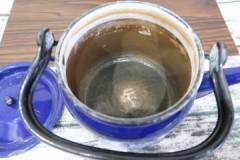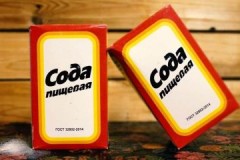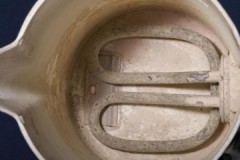Effective ways to remove limescale in a kettle with citric acid
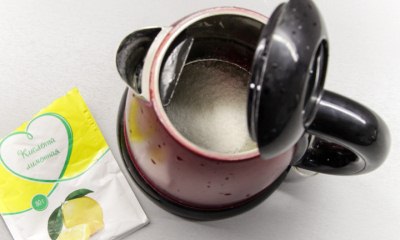 Limescale forms in any kettle - electric and conventional. It accumulates on the walls in a thick layer, which is why the device does not perform well with its main function.
Limescale forms in any kettle - electric and conventional. It accumulates on the walls in a thick layer, which is why the device does not perform well with its main function.
Water from such a container cannot be considered clean. You can cope with the problem using inexpensive improvised means.
About, how to descale a kettle citric acid with the help of folk recipes, read the article on how to remove lime deposits with household chemicals.
Content
Can you clean it?
You can clean the kettle with citric acid. The layer that forms inside is salt deposits. They no longer dissolve in ordinary water. To destroy their hard shell, exposure to more aggressive substances is necessary.
The preservative works exclusively on the surface, dissolving solid deposits. In the future, you can use such a device without fear of health.
How to remove limescale deposits at home?
If the plaque is very dense and firmly fixed on the surface, you can deal with it in the following way:
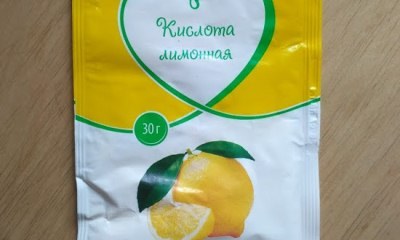 Drain the water from the kettle. Rinse it with warm water, you can walk on the surface with a sponge.
Drain the water from the kettle. Rinse it with warm water, you can walk on the surface with a sponge.- Pour water into the device. It should completely cover those areas where salt deposits are visible.
- Add citric acid. Each liter will require 20 g of powder.
- Put the device on the stove, or turn it on. Wait until it boils. If the kettle is electric, then when it turns off, you need to wait 10 minutes and turn it on again. Water in an ordinary kettle is boiled for 5 minutes.
- Leave the solution inside to act.
- Drain the water, remove the remaining sediment with the hard side of the sponge.
- If the plaque has not been completely removed, the procedure must be repeated.
- To remove the residues of the product, you need to pour clean water into the kettle, boil it and drain it. Then you can use the device as usual.
If the scale layer is small, then you can do without boiling. Features of the procedure:
- draw clean warm water into the kettle;
- add citric acid - 10 g of powder will be required for 1 liter of water;
- leave the kettle to soak for at least 5 hours, if possible, the citric acid solution is kept in the container overnight;
- pour out the water, rinse the device, walking over it from the inside with a sponge.
This procedure will help to deal with plaque if it is barely visible.
How to descale the kettle with citric acid, the video will tell you:
What to add to enhance the effect?
To enhance the effect, the following substances are used together with citric acid:
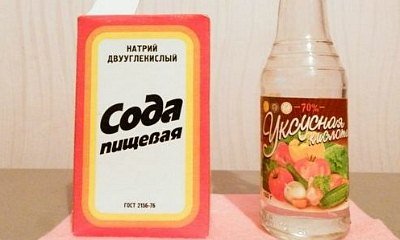 Salt. For every 10 liters of water, 10 g of salt is required.
Salt. For every 10 liters of water, 10 g of salt is required.- Soda. A kettle with a volume of 3 liters will require 30 g of citric acid and 3 tablespoons of soda. They are added together, and then the water is heated without bringing it to a boil. It will take about an hour to completely dissolve the scale.
- Vinegar. If the layer of limescale is thick, you can add 3 tablespoons of vinegar 9% to the citric acid solution. These substances mutually reinforce each other's action. The solution is boiled, left to act for an hour and discarded.
How often should you clean?
The kettle should be cleaned regularly. If the procedure is carried out at least once a month, scale will not form. The cleaning time depends on the quality of the tap water.
Citric acid does not harm the kettle, even with frequent contact with its walls.
Alternative remedies
Citric acid is not the only remedy for limescale. You can cope with it with the help of other substances that are found in every home. Another option is to purchase a special detergent composition in the store.
The best folk recipes (with proportions)
The following substances effectively remove limescale deposits in the kettle:
-
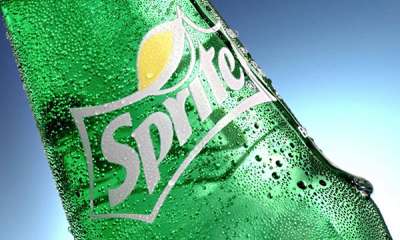 Sprite. This carbonated drink helps to quickly deal with plaque, without harm to the device itself. The drink is poured into a kettle and left open for 20 minutes to allow gas to escape, after which the liquid is brought to a boil and poured into the sink.
Sprite. This carbonated drink helps to quickly deal with plaque, without harm to the device itself. The drink is poured into a kettle and left open for 20 minutes to allow gas to escape, after which the liquid is brought to a boil and poured into the sink.Coca-Cola or Phanto are not recommended as they can stain the plastic kettle.
- Soda and vinegar... They are used in turn. First, the kettle is boiled with a soda solution (20 g per 1 liter). Then it is drained and poured with vinegar solution (5 tbsp. L. Per 5 l of water). This recipe helps to cope with even the most old scale.
- Oxalic acid... It is poured into the device, at the rate of 10 g per 2 liters of water. The solution is brought to a boil, allowed to cool, and then poured into the sink.
How to clean with household chemicals?
You can cope with plaque with the help of specialized household chemicals. The most effective formulations include:
- Topper for descaling the kettle. 1 L of water is poured into the kettle and 100-120 ml of cleaning agent is added. Water is heated to 50 degrees and left for half an hour. The solution is poured, rinsed thoroughly and the container is boiled. The cost of 250 ml is 145 rubles.
- Mellerud. Dilute 60 ml of cleaning agent in 250 ml of water, pour it into a kettle, bring to a boil and turn it off. After 15 minutes, the liquid is drained. The cost of 500 ml of solution is 270 rubles.
- Cinderella "Antinakipin"... Pour 2 liters of water into a kettle, pour the contents of 1 sachet into it and boil for 30 minutes. Then the agent is left to act for 3 hours, the composition is drained, and the dishes themselves are washed with clean water. The cost of a bag of 100 g powder is 30 rubles.
Features for different surfaces
Different materials react differently to cleaning. In order not to spoil the dishes, you need to consider the following points:
 glass - it is not afraid of contact with citric acid, but it cannot be rubbed with a metal brush, as small scratches will appear on the surface;
glass - it is not afraid of contact with citric acid, but it cannot be rubbed with a metal brush, as small scratches will appear on the surface;- plastic - the device normally reacts to the treatment with lemon, but you should not use aggressive acids to clean it;
- metal - the material is resistant to citric acid, it can be rubbed with soft brushes, but do not try to remove scale with a knife or other sharp object.
Helpful information
To ensure that the descaling procedure is effective and healthy, you need to adhere to simple rules:
- Do not drink water from the kettle immediately after the procedure. First you need to boil it with clean water and drain it. Only then can the device be fully used.
- All household members should be warned that the kettle is filled with descaling liquid. This will avoid poisoning.
- Once the cleaning solution has boiled, do not immediately pour it into the sink. The longer it stays inside, the higher the cleaning efficiency.
You can find out about the methods and methods of descaling here.
Conclusion
You can quickly and efficiently remove limescale from a teapot with citric acid. The thicker the layer, the higher the concentration of the solution should be and the longer the exposure time. For prophylactic purposes, cleaning is carried out once a month.

